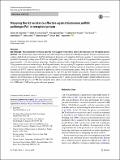Files in this item
Mapping the H2 resistance effective against Globodera pallida pathotype Pa1 in tetraploid potato
Item metadata
| dc.contributor.author | Strachan, Shona M. | |
| dc.contributor.author | Armstrong, Miles R. | |
| dc.contributor.author | Kaur, Amanpreet | |
| dc.contributor.author | Wright, Kathryn M. | |
| dc.contributor.author | Lim, Tze Yin | |
| dc.contributor.author | Baker, Katie | |
| dc.contributor.author | Jones, John | |
| dc.contributor.author | Bryan, Glenn | |
| dc.contributor.author | Blok, Vivian | |
| dc.contributor.author | Hein, Ingo | |
| dc.date.accessioned | 2019-03-01T13:30:06Z | |
| dc.date.available | 2019-03-01T13:30:06Z | |
| dc.date.issued | 2019-04 | |
| dc.identifier | 257988719 | |
| dc.identifier | 97e8fa1d-061b-4795-b5ba-ba2fa6d826af | |
| dc.identifier | 85060492636 | |
| dc.identifier | 000463674000031 | |
| dc.identifier.citation | Strachan , S M , Armstrong , M R , Kaur , A , Wright , K M , Lim , T Y , Baker , K , Jones , J , Bryan , G , Blok , V & Hein , I 2019 , ' Mapping the H2 resistance effective against Globodera pallida pathotype Pa1 in tetraploid potato ' , Theoretical and Applied Genetics , vol. 132 , no. 4 , pp. 1283-1294 . https://doi.org/10.1007/s00122-019-03278-4 | en |
| dc.identifier.issn | 0040-5752 | |
| dc.identifier.uri | https://hdl.handle.net/10023/17187 | |
| dc.description | This work was supported by the Rural & Environment Science & Analytical Services Division of the Scottish Government, the BBSRC, through the joint projects CRF/2009/SCRI/SOP 0929, BB/L008025/1 and BB/K018299/1. Additional funding was obtained through the James Hutton Institute SEEDCORN initiative, AHDB Potato, the Perry Foundation and The Felix Cobbold Trust. Amanpreet Kaur was supported by the Commonwealth Scholarship Commission through a Commonwealth split-site Ph.D. grant. | en |
| dc.description.abstract | Key message: The nematode resistance gene H2 was mapped to the distal end of chromosome 5 in tetraploid potato. The H2 resistance gene, introduced into cultivated potatoes from the wild diploid species Solanum multidissectum, confers a high level of resistance to the Pa1 pathotype of the potato cyst nematode Globodera pallida. A cross between tetraploid H2-containing breeding clone P55/7 and susceptible potato variety Picasso yielded an F1 population that segregated approximately 1:1 for the resistance phenotype, which is consistent with a single dominant gene in a simplex configuration. Using genome reduction methodologies RenSeq and GenSeq, the segregating F1 population enabled the genetic characterisation of the resistance through a bulked segregant analysis. A diagnostic RenSeq analysis of the parents confirmed that the resistance in P55/7 cannot be explained by previously characterised resistance genes. Only the variety Picasso contained functionally characterised disease resistance genes Rpi-R1, Rpi-R3a, Rpi-R3b variant, Gpa2 and Rx, which was independently confirmed through effector vacuum infiltration assays. RenSeq and GenSeq independently identified sequence polymorphisms linked to the H2 resistance on the top end of potato chromosome 5. Allele-specific KASP markers further defined the locus containing the H2 gene to a 4.7 Mb interval on the distal short arm of potato chromosome 5 and to positions that correspond to 1.4 MB and 6.1 MB in the potato reference genome. | |
| dc.format.extent | 12 | |
| dc.format.extent | 3952522 | |
| dc.language.iso | eng | |
| dc.relation.ispartof | Theoretical and Applied Genetics | en |
| dc.subject | QH426 Genetics | en |
| dc.subject | Biotechnology | en |
| dc.subject | Agronomy and Crop Science | en |
| dc.subject | Genetics | en |
| dc.subject | DAS | en |
| dc.subject.lcc | QH426 | en |
| dc.title | Mapping the H2 resistance effective against Globodera pallida pathotype Pa1 in tetraploid potato | en |
| dc.type | Journal article | en |
| dc.contributor.institution | University of St Andrews. Biomedical Sciences Research Complex | en |
| dc.contributor.institution | University of St Andrews. School of Biology | en |
| dc.identifier.doi | 10.1007/s00122-019-03278-4 | |
| dc.description.status | Peer reviewed | en |
This item appears in the following Collection(s)
Items in the St Andrews Research Repository are protected by copyright, with all rights reserved, unless otherwise indicated.

